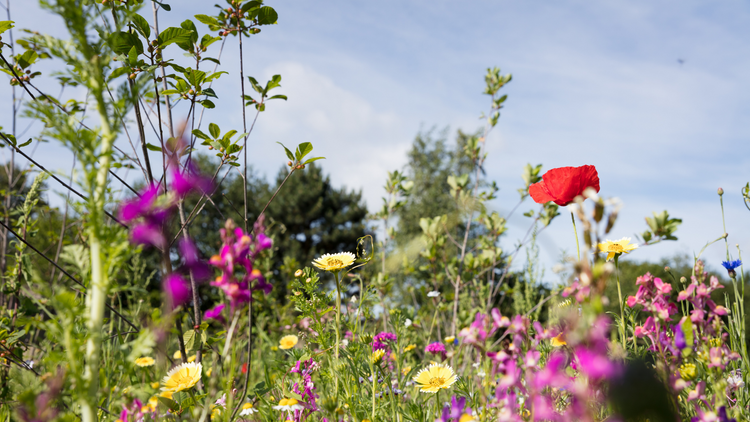April 19, 2022

How To Start A Pollinator Garden This Spring
It’s growing season! AKA: Spring is here and we’re definitely ready for outdoor activities and the pretty colors that bloom around us.
It’s the perfect time of year for growing plants – that time when temperature, amount of daylight and rainfall are all at the perfect complement for growing beautiful flower plants. The length of the growing season varies from place to place. In tropical regions it can last most of the year. For the United States, the warmer Spring and Summer temperatures make it ideal to grow pollinator friendly plants.
Pollination is an important part of a plant’s life cycle. And us humans depend on this process too! One out of every three bites of food we take relies on pollination. This is why pollinator insects, like native bees, butterflies, and moths are our friends.
What is a pollinator garden?
A pollinator garden is any garden planted to feature nectar-rich and pollen-rich flowers for attracting pollinators. These gardens attract honeybees, butterflies, hummingbirds and other insects or creatures that transfer pollen from flower to flower or within flowers.The great thing is that the gardener can get just as much enjoyment out of these gardens as the pollinators do! Many people love to attract and watch butterflies and hummingbirds fly around their garden.
Ready to start gardening?First, we recommend getting good quality gardening supplies. Sunscreen is a must, and adding a nice, brimmed hat will give you extra sun protection for your face and neck. A good pair of gardening gloves keeps your hands safe, and of course gardening tools.

Pro Tip!
And don’t forget to stay hydrated! Drink water throughout the day, especially in warmer temperatures. A day spent outdoors is the best time to enhance your water with True Lemon Original Lemonade. Add one stick to 16 ounces of water and shake up for the perfect refreshing lemonade beverage!
Why have a pollinator garden?
There is an effort for pollinator conservation – creating and preserving gardens and landscapes that help sustain bees and other pollinators. Roughly 1000 kinds of plants are grown worldwide to use in food, beverages, fibers, spices and medicines. All of these need to be pollinated to support the demand of humans.
Because we so heavily rely on pollinators for our food supply, the Million Pollinator Garden Challenge wants to ensure that we keep these bountiful plants and creatures around.
How do I start a pollinator garden?
The good thing is you can use whatever space you have access to for creating a wonderful pollinator habitat. Here are a few easy steps to get you on your way to growing and pollinating!
1. Choose your location. A spot that gets up to six hours of sun per day would be ideal, but any space you have to work with will be fine.
2. Identify your location’s amount of sunlight and the soil type. This plays a part in what pollinators you attract.
3. Choose your plants. Find out what varieties of milkweed and wildflowers are native to your area and grow well in your conditions. Always choose native plants to attract native pollinators.
4. Decide how to start. You can start with either seeds or plants. This may be based on your timeline and budget, but both are good options. Seeds are more economical but require more time to care for and yield results. Plants are more costly but will produce flowers and pollinators more quickly.
5. Prep your garden soil, then plant! When using seeds, disperse them ahead of growing season (in fall or late winter.) This gives them time to germinate. No matter the location, add nutrient-rich soil to improve the success of your garden.
6. Water and watch. Keep your garden clean and healthy, then keep an eye out for the pollinators to start buzzing around! Avoid using pesticides and insecticides which are meant to kill insects.
Consider the types of flowers if you are looking to build a garden for attracting specific creatures, like butterflies or hummingbirds. Colors, shape and fragrance all make a difference. For tips on how to produce the best pollinator garden and attract specific types of pollinators, check out these tips from Gardening Know How.
More on Sustainability



